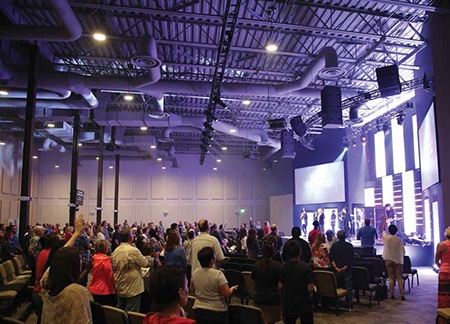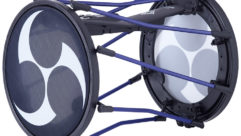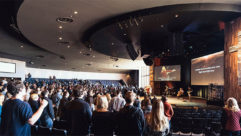

Saddleback is a growing ministry that’s bursting at the seams with new locations. They called in CCI Solutions, headquartered in Olympia, Washington, to outfit their 16th church location with sound, lighting and projection. CCI Solutions is celebrating its 40th year, and charts its roots to worship when Denny Bradley founded the company to do church audio, which in those days meant cassettes and overhead projection. Duke DeJong is here to give us the story.
SVC: Congratulations on the 40th year, I guess things have changed a bit since the days of cassettes.
Duke Dejong: Thank you and yes. In the beginning Denny would literally just go from church to church trying to help them out and cleaning tape machines and whatever we could do. Over the first 10 years of the company the staff grew and started including some engineering students and some audio design acoustical experts, and we quickly added systems integration to our company. So we’ve got a really, really rich heritage, a rich history, and it’s very, very cool to be a part of a company that both has a full sales channel, like any online retailer, but also has a systems integration company that works across the nation. We love it because we get to service our clients from a full audio/video/lighting/acoustics build to “I need four mic cables and a couple more mics to add to my locker.” It certainly can be challenging to do both well. But I think we’ve got some really good people on both sides of the company who get it and get the synergy. It’s very cool to get to serve our customers very holistically that way.
Saddleback Church is not a small outfit. I believe it’s the eighth largest church in the United States based on weekly attendance.
In the U.S., and if you add all their overseas venues, they’re probably a little bit larger. They’ve actually got venues in Europe as well as Asia. They’re based out of Lake Forest, California just outside of Orange County. They’ve got a 3,500-seat auditorium on the main campus that runs something like seven or eight services, I think, a weekend. Plus then they’ve got all of these other venues across southern California and all of them are running various numbers of people, but it definitely adds up. We actually met them about 20 years ago when Acoustic Dimensions designed their PA and we were chosen to be the integrator for the implementation of that, and we’ve done projects with them ever since. Their youth building, the Refinery, I think that was probably 10-15 years ago now. We’ve done a number of LED wall upgrades plus a number of their multisite campuses over the last decade.
So this new location is in what I believe was formerly a health spa in Anaheim?
Yeah. It was – if I remember right it was an L.A. Fitness just across the street from the Angels stadium in Anaheim. I mean literally across the street from the parking lot. They had been meeting portably in a venue across the street and it all of a sudden became available. So it got gutted, it got renovated, and it’s a pretty cool little venue right now.
What did they have for a sound system in there before?
Well, it was all portable so it was kind of pieced-together stuff.
I’m sure that with a portable system it could be just about anything one week and maybe something else the next week.
You know, with most churches that would be true. Saddleback has been doing this a long time and they do portable church a lot better than most people do. So I know it was decent. It wasn’t just hodgepodge, mismatched stuff together. It was definitely something that covered the space that they were working in fairly well, but as often happens as soon as you change venues the needs completely change. And of course instead of going from racks and stacks that are floor supported, now everything’s got to get up in the air so that it’s out of the way and it’s a nice permanent venue.
So when you walked in there and surveyed the site, how did it sound? How were the acoustics?
You know, I wasn’t in super early, but I know from our project manager on the project there was definitely some work to do. But at the same time the whole building was transformed so the building changed significantly inside to accommodate a healthy worship space and kids’ ministry and a good gathering space in the lobby. So really, what it used to be and what it is now is just night and day in every way, shape or form.
Okay. So describe what you put in there. Did they specify exactly what they wanted or did they leave that entirely up to you?
We had just completed a few months beforehand a project up in Riverside, Magnolia Church, and we had actually specified and put in L-Acoustics ARCS WiFo speakers up in that venue. And the tech director at the time at that church used to be one of the former audio guys at Saddleback. So he invited the guys from Saddleback up one day and we just happened to coincide schedules so we were there too and they got a chance to listen. They were really impressed with us, with the PA, and just how warm and yet articulate it sounded. We didn’t do a demo in the space or anything like that. So the next best thing is getting to listen to it in a similar-sized venue, which was the case here. Really there wasn’t a lot of discussion. Once they got a chance to hear it, once we looked at the numbers and how that worked out for their space and, of course, some coverage predictions that our project lead, Mark Pearson, worked up, they were pretty sold pretty quick.
I believe that either you or Mark described the system as a left-right-left design. I don’t think I’ve heard of that one before.
Yeah. The room was wide enough that there had to be three arrays to cover the room evenly and so instead of doing a distributed mono where all three were the exact same, essentially the outside clusters were getting left and the center one was getting right so that there was still some stereo imaging even though it’s not completely accurate to what you see. It does give a little bit of spacing in the mix. So in any areas that are overlapping, they can actually do a little bit of spatial mixing in those sections and just get a little more range out of it.
Speaking of the mixing, did your outfit install the mixer for this?
We did. Most of their campuses have been on Avid consoles, so that one went to an SC-48 to be consistent. One of the things for Saddleback is that not only do they use a lot of contract labor for the weekend tech, but guys will bounce from campus to campus just because all of a sudden somebody’s gone over here so you’ve got to go there. However that ends up working out, keeping that consistency is really critical for them. And if memory serves, they actually already owned the SC-48 so we ended up integrating that into the system because that was the platform they were on.
Yeah, that would make a big difference if they had to travel around to different locations and work all different kinds of mixing consoles with the church people doing all of this. It’s a real advantage in having a nearly identical mixing interface everywhere.
Well, absolutely. At any given time they’ve got all these guys mixing weekend services and these guys have to be able to walk in and set their stuff down and mix without too much hassle. The same for their global tech team as well. They’ve got three or four guys whose job is to make sure all these campuses are cruising and everything is in good shape. So not only from a mixing standpoint, but even from a service standpoint having that consistency across the board as much as possible makes their lives a whole lot easier.
And how do they do the stage monitoring? Do they do that from the main house using auxes?
Yes.
They do?
Yep. That’s pretty normal across most of the Saddleback campuses. Even the main campus, they actually have two consoles front of house. So while they have a separate console mixing monitor it’s still mixed from front of house. Saddleback isn’t like a lot of the churches that have these huge, oversized stages with huge, oversized backstages. A lot of Saddleback’s priority is having seats available. And Pastor Warren, as well as a lot of their campus pastors, being close to the people is a high value for them. So wings for monitor desks and whatnot aren’t normal for them other than for special productions.
That might be an advantage as far as communication between the main house operator and the monitor mixer with them located right next to each other.
Well, for the technicians it is. I think it can be a challenge at times from the monitor engineer to the musicians on stage, but when you’re doing seven or eight services a week, at least at the main campus, once you get that first service or two dialed in it usually goes pretty smooth from there.
So in addition to services, Saddleback Church puts out video and sound to followers all over the world. Is their style high-energy worship style with live music or are they more traditional?
They’re definitely high-energy and they’ve been in kind of a progression over the last five years. They’ve always been very contemporary, but a couple of years ago they definitely began making a shift towards a much more modern style of worship with heavier guitars and more lighting and haze and those kinds of things in a regular worship environment. So this is definitely a very, very modern worship space. It’s got a great, warm, intimate feel to it. Like the sound system especially has to be crystal clear when the message is delivered. Their senior pastor, Rick Warren, is one of the best-known pastors in the world, so it’s obviously a high, high priority for him for speech to be clear, but at the same time that PA has to rock when they want to rock. We’ve done a lot of L-Acoustics systems over the years here and one of the reasons why we keep turning back to them is because they deliver both so well.
And you put in the L-Acoustics ARCS WiFo and I believe you had LA4X amplified controllers in there?
Yeah, l believe that was right and SB-18 subwoofers.
So no problem with the bottom end on the live bands, but going from big music to single mic speech intelligibility can stretch things and some churches, depending on the acoustics, don’t do both exactly right.
Yeah. You know, some speaker systems can handle one or the other really well and then they kind of fall down on the other. But like I said, we’ve had such great success with really any L-Acoustics product we’ve used, but especially this WiFo system. The speakers themselves are extremely articulate, but they have some girth and some meat to it when you need to get up and go. And right now the L-Acoustics subwoofers are some of my favorite out there. They’re just so tight and punchy and clean-sounding that really this system can rock, but at the same time, when it’s as simple as a single spoken mic, it’s as clear as anything you’re going to hear.
That could be interesting with the left-right-left design that you put on this, but the right, I believe, on the outsides and a left channel in the center gives it that spatial stereo effect but everybody still being able to hear everything.
Yeah. The simplest room that’s got a left and a right, most of the time the room doesn’t hear all of left and all of right. So, you know, stereo in a live venue is often imperfect. So this was how we tackle the wide room within perfect stereo. Obviously that space is great when it’s music, but when it comes down to spoken word, it’s a single source. It’s going to rock through all the speakers. It’s going to be delivered and received very evenly. And whether you’re in the front, the back, side to side, you’ve got to be able to connect with the message that’s being communicated.
All of this live music really sets a good, energetic pace but what also sets the mood on this is the lighting and I think your guys did the lighting system on this one as well.
We did, and actually lighting and video were just as critical to them. From a lighting standpoint, because they are very dynamic and do have a very modern style of worship, there is a sufficient number of moving lights and a haze and all of that. It may not be quite as robust as a touring lighting rig, but at the same time it certainly has a great dynamic look to it. Most of the rig – I believe all of the rigs – is actually LED. Low maintenance – this being, again, of a few dozen sites it’s all got to be very user-friendly. They don’t want to be out there changing bulbs all the time. So with Chauvet putting out a lot of great fixtures like they’ve been doing lately, we were actually able to do a complete LED rig for the stage lighting with their Ovation E-190 ellipsoidal fixtures. All the movers are Chauvet Rogue R-1 wash, R-1 spots, and there were a couple of R-2 spots as well. And all the house lighting were LED as well. So the entire system is very low-maintenance as well as lower-cost in regards to electricity and power consumption and heat production.
Where do they control the lighting from? Is that out there next to the front of house sound mixer?
Yeah. It’s in front of house. At the Anaheim campus audio, video and lighting are all at front of house. It’s got a lot of capability there, but it’s all very compact. And video is really fairly simple for the venue, but as I mentioned it’s actually highly critical because they will generally pipe in the message from the main campus in Lake Forest. So not only do the side screens have to support the worship service, or if there’s a local speaker but there’s a large center screen that drops and has to be crystal clear and beautiful and engaging for when pastor is piped in from the main campus.
And you did the projection on this, too. What did you use for that?
We did. It’s all Christie projectors. So they’ve been on Christie projectors on most of their campuses and have had very good luck with it and have had good support from them over the years, and so if it ain’t broke, why fix it?
Yeah. So what sort of video signal transmission do they use? How do they get the video to the projectors?
For the local stuff it’s all done like most searches. It’s a computer running ProPresenter software for motion graphics and lyrics and whatnot. For the message time they’ve actually got a Grass Valley T2 Pro in there that is essentially playing back the message from the main campus.
And I know that once things get going in there that’s a lot of stuff to coordinate. If one thing stops working it can have a domino effect. But it sounds like you got the job done and they’re going right along with all the new stuff.
Yeah. That campus has done really well. In our world, quite often no news is good news and so far, since that campus has been open, the only time we hear about it from them is when they’re happy.










